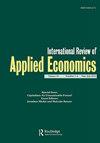并不是所有的僵尸都生而平等。马克思-明斯基的企业分类:美国,1950-2019
IF 1.6
Q3 ECONOMICS
引用次数: 0
摘要
摘要“僵尸”文献强调企业的财务特征,并侧重于解释其崛起的财务渠道。这是不完整的,因为它将具有不同生产特征的公司混为一谈。根据马克思和明斯基的见解,我们建立了一个企业分类法,根据企业的利润率及其三个决定因素之间的相互作用来显示其生产和财务特征:利润率、利润与利率之间的差异和杠杆率。考虑到这些变量的不同可能组合,我们将企业分为七类:正常和常规小资本(对冲金融);投机性小额、超小额和杠杆式小额资本(投机性金融);以及资金紧张的小型和僵尸资本(庞氏金融)。我们展示了1950年至2019年美国上市公司的组成和演变,以及按公司类型划分的相关描述性统计数据。我们的主要发现是,美国公司的主要问题是生产性的,而不是财务性的,因为即使在支付利息之前,尽管杠杆率相对较低,但仍有很大一部分公司的盈利能力越来越负。本文章由计算机程序翻译,如有差异,请以英文原文为准。
Not all zombies are created equal. A Marxist-Minskyan taxonomy of firms: United States, 1950-2019
ABSTRACT The ‘zombie’ literature emphasizes the financial characteristics of firms and focuses on financial channels to explain their rise. This is incomplete because it conflates together firms with very different productive characteristics. Drawing on Marx and Minsky’s insights, we build a taxonomy of firms showing both their productive and financial characteristics based on the rate of profit of enterprise and the interplay between its three determinants: the profit rate, the difference between the profit and the interest rate, and the leverage ratio. Considering the different possible combinations of these variables, we classify firms into seven types: normal and regular small capitals (hedge finance); speculative small, super small, and leveraged small capitals (speculative finance); and financially stressed small and zombie capitals (Ponzi finance). We show the composition and evolution of U.S. listed firms as well as relevant descriptive statistics by type of firm from 1950 to 2019. Our main finding is that the principal problem of U.S. firms is productive, not financial, as there is a high share of firms with increasingly negative profitability even before the payment of interest and despite having relatively low leverage.
求助全文
通过发布文献求助,成功后即可免费获取论文全文。
去求助
来源期刊

International Review of Applied Economics
ECONOMICS-
CiteScore
4.30
自引率
4.50%
发文量
37
期刊介绍:
International Review of Applied Economics is devoted to the practical applications of economic ideas. Applied economics is widely interpreted to embrace empirical work and the application of economics to the evaluation and development of economic policies. The interaction between empirical work and economic policy is an important feature of the journal. The Journal is peer reviewed and international in scope. Articles that draw lessons from the experience of one country for the benefit of others, or that seek to make cross-country comparisons are particularly welcomed. Contributions which discuss policy issues from theoretical positions neglected in other journals are also encouraged.
 求助内容:
求助内容: 应助结果提醒方式:
应助结果提醒方式:


